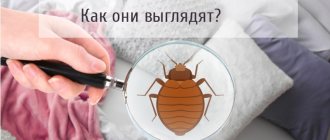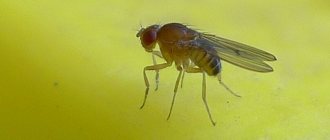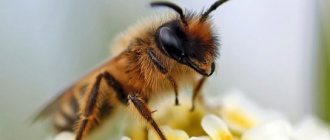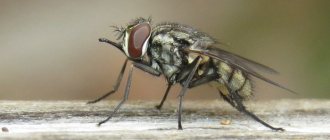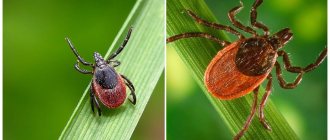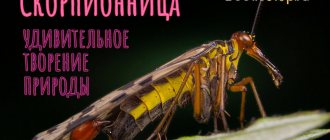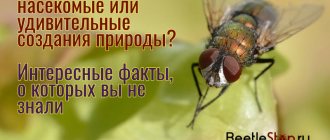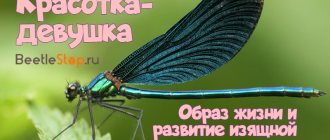Review author: “ZooVita”
The fly, an insect familiar to every person, is part of the order Diptera. Among flies, there are both those living in the wild and those closely associated with human settlements.
And although it is known that flies can harm human health, many interesting questions regarding these insects remain open, for example, how long do flies live or how do they reproduce?
House fly or house fly.
The housefly is the most common type of fly that can be found in and around apartments, private houses.
This type of fly is synanthropic to humans, is rarely found outside human settlements, and is adjacent to humans. House flies are quite harmful insects that constantly scurry around the house; these pests are potential carriers of diseases.
House flies have a short lifespan of about 1.5 months, but they can multiply quickly, leading to the formation of large populations of flies if they are not eradicated in time.
The house fly is active during the day. On the street, flies prefer to hang around plants,
Diversity
In the modern period, taxonomies include about 40 thousand species of flies. The most common among them is home, or room. It is gray in color with a specific break in the wings. But the bright emerald fly, despite its visual attractiveness, is especially dangerous. This species lives exclusively on carrion and sewage.
Not all flies are associated with human life. For example, the hoverfly feeds exclusively on nectar. Outwardly, it is very similar to a wasp with transparent wings. But the fly, the description of which we will present now, is not at all a harmless creature. They call her Tsetse. This African species carries parasitic single-celled organisms called trypanosomes. They cause sleeping sickness, which is characterized by fever, weakness and unconsciousness.
So, a fly is an insect that is a representative of the Diptera order. A systematic feature is the presence of halteres. This structure is a modification of the second pair of wings, providing balance during flight. The average lifespan of flies is 20 days, and mayflies are 24 hours. Most species live near or inside human homes, feeding on human food. The negative significance of these insects is that they are carriers of dangerous diseases of humans and animals. Therefore, controlling flies and preventing their contact with food is an important requirement for hygiene.
Source
What do house flies look like?
Features of the structure and life of the housefly:
- Color: dark gray, four longitudinal stripes on the top of the chest
- Reproduction: bisexual (male and female)
- Development: approximately 20 days
- What does a fly do in winter: hibernate in all stages. Located in the corners and edges of the room, they can survive cold winters by hibernating.
- How many legs (legs) does a housefly have: 6 legs
- Body shape: small, oval
- Size: Adults are about 4–7.5 mm long.
- Presence of antennae: yes
- Where they are distributed: throughout Russia, found almost everywhere where there is a person. Flies appeared since the Cenozoic era and today, following people, they have colonized the entire planet.
- Lifespan of a housefly: up to 1.5 months
- Houseflies are usually gray in color with four black stripes on the chest.
- Adult houseflies range from 4 to 7.5 mm in length.
- The fly's body is covered with small hairs and has one pair of wings.
- Female house flies are usually larger than males.
- House flies have neither teeth nor stingers.
Aerodynamic properties
The flight of a fly is a unique phenomenon, the nature of which scientists still cannot fully understand. Insects move quickly, have excellent maneuverability, and change direction almost instantly.
Flight Features
The flight of a fly has several features:
- acceleration is not required for takeoff;
- hovering in the air;
- sudden change in trajectory;
- covering long distances without reducing speed;
- hard landing.
A fly can change direction many times in flight without slowing down at all. Most often they fly in zigzags.
Height
Usually flies do not need to rise high, because they mainly find food on the ground. But flies fly at a height of 7–10 floors, and if necessary they can rise higher. How high the fly rises is greatly influenced by the speed and direction of the wind.
Range and speed
The average speed of a fly is about 3 km/h, but if necessary, the insect can fly at speeds of more than 6 km/h. The flight speed of a fly depends on its size, how hungry it is, and how strong the reproductive instinct is.
But scientists have not yet been able to find out how many kilometers a fly can fly without resting. After all, usually the movement of a fly is limited to covering a short distance, after which it lands.
Flying in the rain
If you have to fly during the rain, most often the insect will not be harmed and, moreover, will remain dry. It's all about the visual characteristics of these insects, as well as the speed of reaction.
In flight
Attention! A fly in flight sees all the drops approaching it and can maneuver to avoid them.
How many eyes does a housefly have?
Insects for the most part have a pair of compound eyes, which consist of individual small lenses (facets or ommatidia). The house fly has red-brown eyes.
Each facet is a lens, a housefly has 4000 of them in each eye, this allows flies to have “excellent” visual vision, but their visual acuity is a hundred times worse than that of a human, the fly sees normally only at a distance of 40-70 cm, so flies have 3 non-compound eyes. It turns out that the fly has 5 eyes (2 eyes of the main compound eyes and 3 ordinary eyes)
Internal structure
The main internal organs of the fly are located inside the abdomen. These are the genitals and digestive organs, the circulatory system, the respiratory system and the nervous system.
Reproductive system
The reproductive system includes accessory glands, ducts, as well as testes in males and eggs in females. External appendages differ depending on the species. Most flies lay eggs, but some species are viviparous - females give birth to larvae.
Digestive system
The digestive system consists of the crop, intestines, Malpighian vessels and excretory tubules. Flies are insects with external digestion. That is, food digestion occurs outside the body, under the influence of a special secretion injected by the fly. After this, the insect sucks up the resulting liquid.
Other organs and systems
Other organs and systems of the fly's body:
- the brain is a large number of nerve plexuses that are located in different parts of the body and perform the main function of coordinating the behavior of the insect;
- respiratory system - a complex system of tracheas located throughout the body and opening outward with spiracles;
- circulatory system - includes the aorta, heart, pterygoid muscle and dorsal vessel.
How do houseflies reproduce?
The life cycle begins when a fertilized female house fly finds a suitable place to lay her eggs, often in feces, carrion or garbage.
At one time, a female can lay up to 150 eggs, and in 1 month 1200-2000 eggs.
The development of a fly from egg to adult can take as little as six days.
Fly eggs resemble small grains of rice. The eggs hatch into larvae that range in size from 7-13mm in length and can hatch within 12-24 hours in warm weather. The larvae are cream colored and feed on the oviposition for three to five days. Over the course of three to six days, the pupae develop legs and wings and mature into adult house flies.
After two to three days, the adult female housefly is completely ready to reproduce, resuming its life cycle. Adult houseflies usually live 15-25 days, sometimes longer.
Ilnitsa-beeweed (tenacious Ilnitsa)
This type of fly belongs to the hoverfly family. In appearance they are similar to an ordinary bee. The average length is 1.5 cm. The abdomen is dark brown in color, covered with plumage of small hairs; on the side there are large red spots with a yellowish tint. In the middle part of the fly's face there is a wide, well-developed shiny black stripe. Before our eyes - two
vertical stripes with thick hair. The hind limbs in the lower leg area are also covered with hairs. The insect's thighs are almost black.
The larva of the bee moth is dark with a gray tint. The body of the larvae has a cylindrical shape and reaches a length of 10–20 mm. The larva breathes using a special breathing tube, which can stretch up to 100 mm in length. This organ is very important for her, since she lives in conditions of fetid liquids, garbage pits and pond sewage, and can only breathe clean air.
This insect is active from July to October. Illices feed on the nectar of various flowering plants.
Beeworm larvae can be the source of a dangerous intestinal disease found in some European countries, Africa, Australia, Chile, Argentina, India, Iran and Brazil.
The disease occurs as a result of fly eggs entering the human intestines along with food. There the larva hatches and begins to develop, causing enteritis.
Why is it necessary to control house flies?
Houseflies don't bite, but they can carry more than 100 different pathogens, including salmonellosis, cholera, typhoid fever and tuberculosis. Houseflies infest food surfaces, spreading disease-causing organisms found on their feet and mouths when feeding on garbage, feces and other decaying matter. In addition, they constantly defecate.
The house fly is a carrier of:
- cholera;
- dysentery;
- eye diseases (in particular purulent inflammation of the eyelids and trachoma);
- typhoid fever;
- tuberculosis;
- diphtheria;
- paratyphoid;
- anthrax;
- protozoan cysts;
- possible tissue and intestinal myiases (from fly larvae)
Ktyri
Slender, predatory flies are quite large in size. The body and limbs are covered with a thick layer of short hairs. For humans, blackflies do not pose any danger, but insects such as mosquitoes, midges, beetles and even bees are quite rightly
they are afraid.
Ktyrs obtain food by hunting in the air, clutching the caught prey with their tenacious long paws. After this, they stick their sting into the defenseless body to inject poison into it and calmly suck out the contents. Sometimes another ktyr can become the prey of a ktyr.
This predatory fly brings great benefits to humanity, killing and eating many different dangerous insects. The larvae of moths are also predators. They live in rotten wood, soil and other rotting matter, where their food is various small insects and other larvae.
Prevention measures against house flies
- To avoid infestation by house flies, it is necessary to keep the room in order.
- It is necessary to regularly take out the trash and cover the trash can with a lid.
- Garbage cans must be removed at least once a day and be covered with lids.
- Pet waste must be thrown away
- Install mosquito nets on windows and doors
- Air curtains must be installed on doors to retail premises
- Container sites must be concreted
- Extermination measures should be carried out in the presence of flies
Gadfly
Yes, gadflies also belong to synanthropic flies, although many, due to their “fluffiness,” are more reminiscent of bees or bumblebees.
These are large (up to 3 cm in length) insects with a gray or yellowish, sometimes striped body, abundantly covered with hairs.
Gadflies in our latitudes do not attack or bite humans. They are dangerous parasites of large animals - a person can suffer from these insects only if the eggs of the gadfly somehow get on his mucous membrane or under the skin. But if a female gadfly decides to pierce your skin to lay larvae, you will notice this by large swelling and redness, as well as severe itching. Botfly larvae can also cause myiasis.
- 7 dangerous insects that lie in wait for us in the country and beyond
Rating of insects, after bites of which you need to urgently take safety measures.
Lifestyle
- Jungle animals
- Saber-toothed tiger
- 50 facts about kangaroos
- long eared hedgehog
- Cross spider
- Reptiles
The housefly is, of course, a subspecies of the common wild fly, which over time became so addicted to, albeit unsafe, but such comfortable and fertile cohabitation with humans, that it spontaneously branched off from its native taxon and formed a new one. This is how house flies appeared - regulars in kitchens, balconies, verandas and rooms. These insects live mainly in those houses and apartments where there is always something to eat. They are attracted by the smells of something edible, especially rotten fruits, vegetables, and meat products. They have a licking-sucking apparatus, so they do not pose any danger to humans in terms of bite.
The fly is an exclusively diurnal insect. At night they see almost nothing and therefore sleep. During the day they are tireless in their activity.
House flies reproduce very quickly and easily, and can create a considerable problem for a careless owner, under favorable conditions, causing a real invasion. After all, flies appear in the home environment most often under conditions of “sanitary liberalism” on the part of the owners, this should not be forgotten. In this case, you have to take measures to reduce the number of bred flies to at least an acceptable minimum, but that’s a slightly different story. By the way, about the lifespan of house flies. It ranges from two weeks to a month. If no one tries to shorten the fly’s lifespan, the lifespan of the annoying parasite largely depends on the temperature parameters of its habitat. Acceptable limits are 10-40 degrees. At lower temperatures, closer to zero, the fly begins to seek shelter for the winter. At minus degrees the insect dies.
Harm and benefit
Housefly Houseflies
greatly annoy people with their presence. Their annoying buzzing makes you nervous. What makes the situation worse is the fact that the pest is difficult to catch and kill. Before the person has time to swing, the housefly has already taken off from its place.
However, this is not the only harm. Insects live in an environment that is teeming with pathogens - feces, slops, garbage cans, rotting products. Their paws carry E. coli, infections, and spread dangerous diseases and worms.
Larvae, when ingested with food, can cause myiasis of internal organs and eyes. The parasite does not go through its full life cycle, but during its presence in the body it causes significant harm. With myiasis, the intestines come out with vomit and feces. If the larva continues to develop in the eye, surgery is required, complications are possible, including complete loss of vision.
But man figured out how to make even these flies do some good. Maggots are used as food for pets - amphibians, fish, lizards, birds. Used as bait for fish. There is a special fishery for breeding maggots in special conditions. After purchasing live food, store it in the refrigerator to prevent pupation.
Links
- [bse.sci-lib.com/article063477.html Housefly] in TSB
- [creatures.ifas.ufl.edu/urban/flies/house_fly.htm Housefly] on the website of the University of Florida Institute of Food and Agricultural Sciences (English)
- [www.ncbi.nlm.nih.gov/entrez/query.fcgi?cmd=Retrieve&db=pubmed&dopt=Abstract&list_uids=11902690&query_hl=1 Dübendorfer A, Hediger M, Burghardt G, Bopp D. Musca domestica, a window on the evolution of sex -determining mechanisms in insects. Int J Dev Biol. 2002, 46(1):75-9.] (English)
- [scholar.google.com/url?sa=U&q=taylorandfrancis.metapress.com/index/0HWHMF75LPPG7YP6.pdf Brian M. Wiegmann, David K. Yeates, Jeffrey L. Thorne, Hirohisa Kishino Time Flies, a New Molecular Time-Scale for Brachyceran Fly Evolution Without a Clock. Systematic Biology. 2003, 52(6):745-756] (English)
Description
The body varies in length. Often the length reaches 2 cm. There is a proboscis on the head. Its purpose is to absorb and absorb liquid.
The entire body of the fly will have only three parts. This is her head, her body and abdomen. The legs are three pairs. It is interesting that each such tiny leg, in turn, is also divided into 5 parts.
One of the 5 particles will be a foot and it, in turn, has two sharp claws. It is equipped with sticky pads.
And only these features will allow the front sight to move along the ceiling and any other vertical surfaces.
